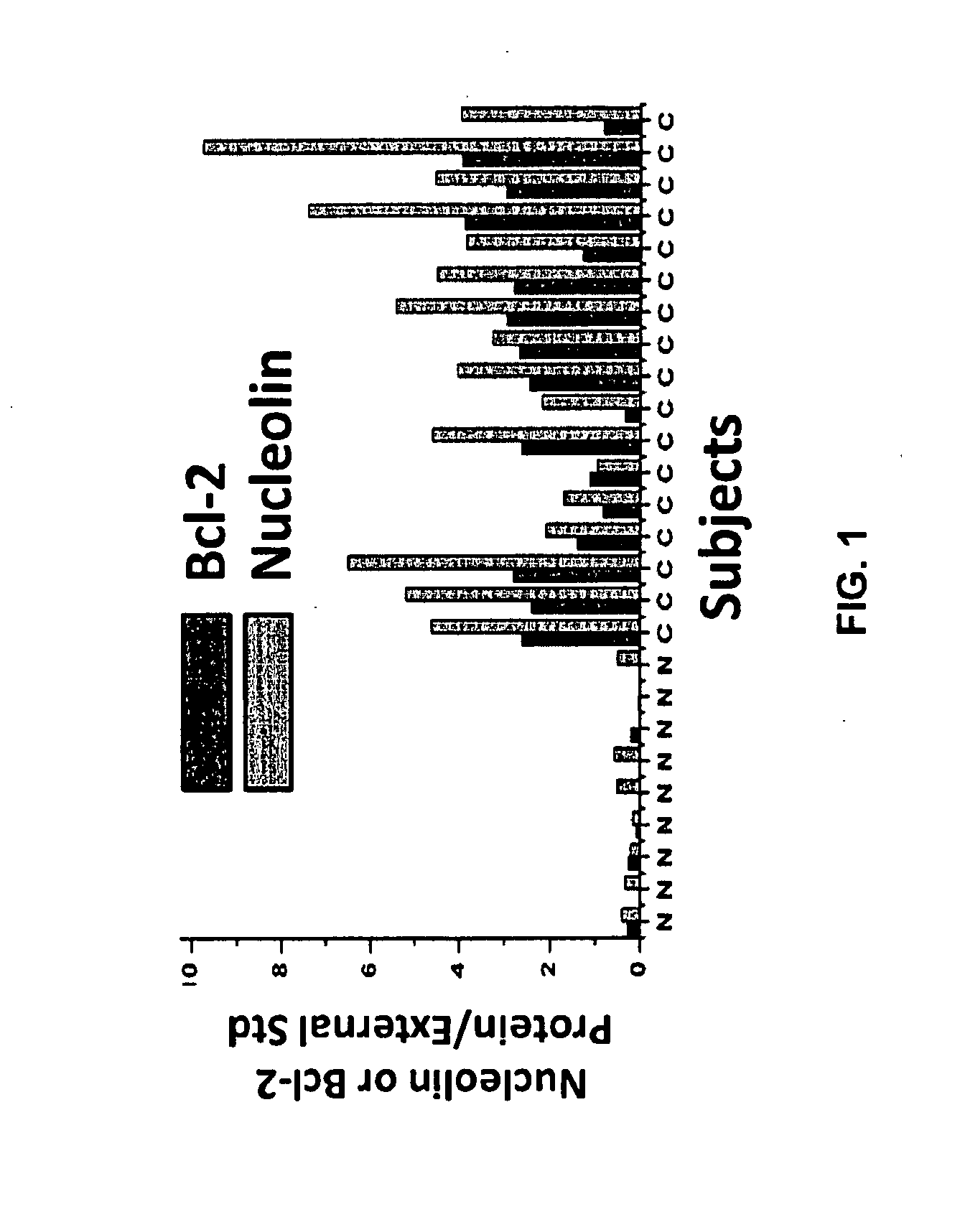Human Monoclonal Antibodies to Human Nucleolin
a technology of human nucleolin and monoclonal antibodies, which is applied in the field of cell biology and immunology, can solve the problems of limited success, limited specificity of certain targets, and large untapped potential for therapeutic and diagnostic agents, and achieves the effects of reducing bcl-2 levels, inducting complement-dependent cytotoxicity, and reducing bcl-2 levels
- Summary
- Abstract
- Description
- Claims
- Application Information
AI Technical Summary
Benefits of technology
Problems solved by technology
Method used
Image
Examples
example 1
Materials & Methods
[0355]Isolation and Culture of Tonsil B Cells.
[0356]To prepare B cells from tonsils, tonsil tissue was placed inside a sterile Petri dish (VWR International, cat. #25384-088) containing 20-30 ml Dulbecco's phosphate buffered saline (DPBS, without CaCl2 or MgCl2; Gibco / Invitrogen, Grand Island, N.Y. cat. #14190144) supplemented with 1× Antibiotic-Antimycotic (Gibco / Invitrogen cat. #15240-062). The tissue was chopped and minced with scalpels to approximately 1 mm3 pieces. Additional lymphocytes were released by gentle grinding of tonsil pieces between the frosted glass surfaces of two sterile microscope slides (VWR cat. #12-550-34), and single cell preparation was made by straining through 70 μm nylon strainer (BD Falcon, cat. #352350, BD Biosciences, Two Oak Park, Bedford, Mass.). This suspension was layered onto a Ficoll (Amersham Biosciences cat. #17-1440-03, Uppsala, Sweden) cushion (35 ml sample over 15 ml Ficoll) and resolved at 1500 G for 20 min. The boundary...
example 2
Results
[0514]Nucleolin and Bcl-2 Protein are Overexpressed in the Plasma Membrane And Cytoplasm of B-CLL Cells Compared to B Cells from Normal Human Volunteers.
[0515]CLL is indolent during most of its clinical course and the clonal B cells accumulate in the bone marrow and circulation during the indolent phase by avoiding apoptosis (Klein et al., 2000). CLL cells circumvent apoptosis by over-expressing the anti-apoptotic protein Bcl-2. High-level expression of bcl-2 mRNA and protein is seen in the absence of gene rearrangements that are known to enhance bcl-2 transcription (Bakhshi et al., 1985; Robertson et al., 1996; Steube et al., 1995). One of the inventors discovered that bcl-2 mRNA is highly stabilized in CLL cells from patients compared to normal CD19+ B cells from healthy volunteers (Otake et al., 2007). In addition, the inventors showed that the enhanced stability of bcl-2 mRNA in CLL cells was a direct result of binding of the stabilizing protein nucleolin to an ARE elemen...
PUM
| Property | Measurement | Unit |
|---|---|---|
| Fraction | aaaaa | aaaaa |
| Fraction | aaaaa | aaaaa |
| Time | aaaaa | aaaaa |
Abstract
Description
Claims
Application Information
 Login to View More
Login to View More - R&D
- Intellectual Property
- Life Sciences
- Materials
- Tech Scout
- Unparalleled Data Quality
- Higher Quality Content
- 60% Fewer Hallucinations
Browse by: Latest US Patents, China's latest patents, Technical Efficacy Thesaurus, Application Domain, Technology Topic, Popular Technical Reports.
© 2025 PatSnap. All rights reserved.Legal|Privacy policy|Modern Slavery Act Transparency Statement|Sitemap|About US| Contact US: help@patsnap.com



